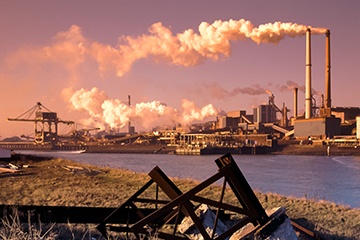 From 1868 to 1988, the Geneva Foundry operated in Geneva, NY manufacturing cast iron components. According to historical records the site did not have pollution control on its smokestack until 1970. Even after that, the controls did not work as they should have. The foundry used recycled iron that contained lead and other metals while the furnaces burned coal containing arsenic and mercury. In 1986, a neighbor to the foundry complained to the New York State Department of Environmental Conservation about chemical drums that were leaking near their property. That complaint led to major contamination discovery 30-years later.
From 1868 to 1988, the Geneva Foundry operated in Geneva, NY manufacturing cast iron components. According to historical records the site did not have pollution control on its smokestack until 1970. Even after that, the controls did not work as they should have. The foundry used recycled iron that contained lead and other metals while the furnaces burned coal containing arsenic and mercury. In 1986, a neighbor to the foundry complained to the New York State Department of Environmental Conservation about chemical drums that were leaking near their property. That complaint led to major contamination discovery 30-years later.
While in operation, the foundry went more than a century without any environmental checks. For more than 120 years, the factory sent lead, arsenic, benzenes, chromium and mercury particles into the air, which settled in the surrounding neighborhoods. In 1986, after the neighbor complaint, the chemical drums were removed, and oil samples were collected from the neighbor’s property. According to a recent newspaper article, “The results showed higher-than-expected levels of lead, zinc and cadmium… Vegetables from the garden, especially green beans, contained lead.”
After the analysis, the state health expert at the time wrote an internal memorandum “concluding that people were at risk of lead poisoning and neighbors should be warned.” There was no indication that the warning was issued.
Jump forward to 2016, when in early October, state officials notified nearly 100 residents that “their soil contained lead or arsenic in concentrations that are considered unsafe.” The state tested soil at 107 properties and 98 of them “contained one or both metals in concentrations that are considered unacceptably high.”
The 2015 soil sample tests found arsenic levels averaging 25 parts per million with the highest at 228 ppm. An acceptable concentration level is 16 ppm. Lead concentration levels in the soil averaged 506 ppm with some locations exceeding 1,000 ppm. Normal soil in Geneva is in the 100-200 ppm range.
Arsenic causes skin problems and cancer if ingested in large enough quantities, and drinking water is the most common source of arsenic contamination. Of more concern to the state and local residents is the level of lead in the soil, which poses a serious health risk to children. An Australian researcher published a study in 2016 that indicated, “The primary pathway for the human exposure and uptake of lead in children is via inadvertent ingestion of lead-contaminated soils and dust, and subsequent absorption in the intestines.” The exposure to lead can cause lower Intelligence Quotient (IQ), and cause learning disorders, and behavioral problems.
In January 2017, the DEC released the final remediation plan for the foundry site and neighboring properties that includes excavation of contaminated soil, replacement with clean soil and continued monitoring. The cost of the cleanup project will exceed $16.8 million. Up to one foot of the lead contaminated soil will be removed from 220 properties and will be replaced with at least six inches of clean soil for vegetation and gardening. The remediation project will begin sometime in 2017.
Teledyne CETAC ASXpress Plus Rapid Sample Introduction system and the U5000AT+ Ultrasonic Nebulizer are used in laboratories to test soil for lead.
The ASXpress PLUS Rapid Sample Introduction System is used for high throughput of digested soil samples and the U5000AT+ Ultrasonic Nebulizer is used for enhanced detection of more difficult to detect elements such as arsenic (As) and lead (Pb) when using ICP-AES.
If you are interested in more information on these products, visit our website at www.cetac.com or contact us for more information.


